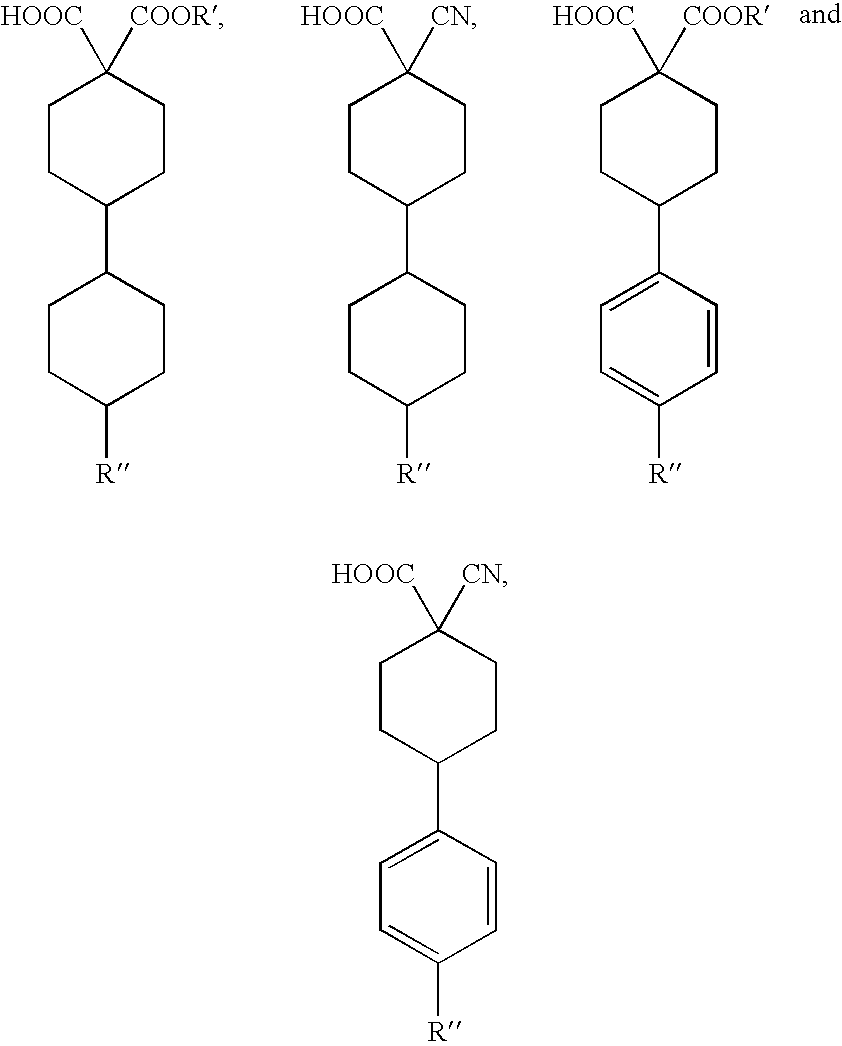Preparation of organic compounds bearing a trifluoromethyl group on a quaternary carbon
- Summary
- Abstract
- Description
- Claims
- Application Information
AI Technical Summary
Problems solved by technology
Method used
Image
Examples
example 1
Fluorination of 1-carboxy-1-carbomethoxy-4(4′-propylcyclohexyl)cyclohexane with sulfur tetrafluoride
[0034]4.2 g of 1-carboxy-1-carbomethoxy-4(4′-propylcyclohexyl)cyclohexane were placed in a 75 mL Hoke cylinder fitted with a tee connected to a relief device and an inlet valve and containing a magnetic stir bar. The Hoke cylinder was evacuated and cooled to −78° C. 9.4 g of hydrogen fluoride were vacuum transferred into the cooled cylinder along with 9.5 molar equivalents of sulfur tetrafluoride. The valve on the cylinder was closed and it was allowed to warm up to room temperature. The reaction was allowed to stir at room temperature for 24 hours. The volatiles were evacuated from the Hoke cylinder and the residual contents were extracted with diethyl ether and neutralized over sodium bicarbonate. The mixture was filtered, concentrated and passed through a plug of silica gel, eluting with 2-4% ethyl acetate in hexanes (vol / vol). A GC-MS chromatogram showed four product peaks, corres...
example 2
Reduction of 1-trifluoromethyl-1-carbomethoxy-4-(4′-propylcyclohexyl)cyclohexane with lithium aluminum hydride
[0035]200 milligrams of lithium aluminum hydride were placed in a dry two-neck 100 mL round bottom flask under nitrogen. 10 mL anhydrous tetrahydrofuran were added and the flask was cooled to 0° C. in an ice bath. 1.45 g of 1-trifluoromethyl-1-carbomethoxy-4-(4′-propylcyclohexyl)cyclohexane were dissolved in 6 mL anhydrous tetrahydrofuran and added dropwise to the reaction flask. The reaction was stirred for 1 hour at 0° C. and then 4 hours at room temperature. The reaction mixture was diluted with diethyl ether and 0.25 mL water was slowly added, followed by 0.25 mL 15% NaOH(aq), followed by 0.75 mL water. The mixture was stirred overnight. After filtration of the aluminum salts, the organic phase was washed twice with water, dried over magnesium sulfate, filtered and concentrated to yield 1.0 g of product. A GC-MS chromatogram showed three distinct peaks (presumably the fo...
example 3
Oxidation of 1-trifluoromethyl-1-hydroxymethyl-4-(4′-propylcyclohexyl)cyclohexane with chromic anhydride / pyridine
[0036]1.0 g of chromic anhydride was placed in a dry two-neck round bottom flask under nitrogen. 10 mL anhydrous methylene chloride were added followed by 1.7 mL anhydrous pyridine. The mixture was allowed to stir for 40 minutes at room temperature. 1.0 g of 1-trifluoromethyl-1-hydroxymethyl-4-(4′-propylcyclohexyl)cyclohexane was added in 6 mL anhydrous methylene chloride and allowed to stir over a weekend. The reaction was diluted with ether and the precipitate was filtered through celite. The organic phase was washed twice with dilute HCl solution, once with NaHCO3 solution and once with water, followed by drying over magnesium sulfate and evaporation of the solvents yielded 0.59 g of material. A GC-MS chromatogram showed peaks with a molecular ion peak (m / z=302).
PUM
 Login to View More
Login to View More Abstract
Description
Claims
Application Information
 Login to View More
Login to View More - R&D
- Intellectual Property
- Life Sciences
- Materials
- Tech Scout
- Unparalleled Data Quality
- Higher Quality Content
- 60% Fewer Hallucinations
Browse by: Latest US Patents, China's latest patents, Technical Efficacy Thesaurus, Application Domain, Technology Topic, Popular Technical Reports.
© 2025 PatSnap. All rights reserved.Legal|Privacy policy|Modern Slavery Act Transparency Statement|Sitemap|About US| Contact US: help@patsnap.com



